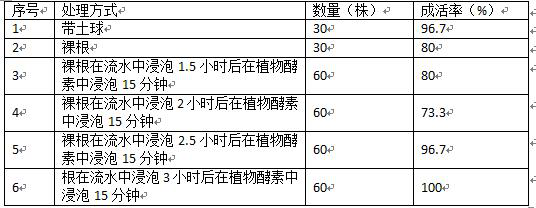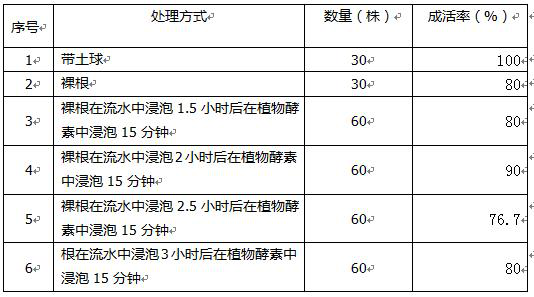Bare root afforestation method for fleshy root saplings
A technology of fleshy roots and saplings, applied in afforestation, forestry, agriculture, etc., can solve the problems of lost root protection, damage to the cultivated layer of cultivated land, and high labor intensity, so as to reduce the labor intensity of handling, promote rapid rooting, and alleviate labor difficulties Effect
- Summary
- Abstract
- Description
- Claims
- Application Information
AI Technical Summary
Problems solved by technology
Method used
Image
Examples
Embodiment 1
[0026] Example 1: Afforestation test tree species: hackberry
[0027] The selected 240 hackberry trees with a ground diameter of 6-8cm are centered on the tree stem and 6 times the diameter of the seedling ground, and the saplings are dug out in a spherical shape. All the saplings are cut off the pole at a height of 3.5m and pruned, of which 30 are Pick up the soil balls and wrap them with cloth tapes; after the other 210 plants are taken out, use a high-pressure water pump to flush out the soil at the roots, 180 plants are soaked in the creek for 3-5 hours, and the other 30 plants go directly to the mountains for afforestation. The methods and survival rate survey results are shown in Table 1. The size of the planting hole is 80 × 80 × 50 cm. When planting, first backfill the topsoil in the center of the hole 15 cm to the shape of a steamed bun, insert the taproot of the sapling into the topsoil of the steamed bun, and continue to backfill the soil to 25 cm. Use a wooden stic...
Embodiment 2
[0031] Embodiment 2: Afforestation test tree species: Zhejiang camphor
[0032] The selected 300 zhejiang camphor trees with a ground diameter of 4-5cm are taken as the diameter of 7 times the ground diameter of the seedlings, and the saplings are dug in a spherical shape. All the saplings are cut off and trimmed at a height of 2.8m, and 30 of them are in the way of soil balls. It is good to use cloth tape to wrap it up; after the other 270 plants are lifted out, use a high-pressure water pump to wash away the soil at the roots, 240 plants are soaked in the creek for 1.5-3 hours respectively, and the remaining 30 plants go directly to the mountains for afforestation. For specific treatment methods and results, see Table 2. The size of the planting hole is 50 × 50 × 40 cm. When planting, first fill the topsoil in the center of the hole 15 cm to the shape of a steamed bun, insert the main root of the sapling into the top soil of the steamed bun, and continue to backfill the soil...
Embodiment 3
[0036] Example 3: Afforestation Test Tree Species: Huadong Nan
[0037] Selected 300 selected saplings with a ground diameter of 2-3cm and a tree height of 1.5-1.8m. The diameter is 7 times the ground diameter of the seedlings. The saplings are dug in a spherical shape and pruned. Among them, 30 plants are made of cloth with soil balls. Bandage; after the other 270 plants were taken out, the soil at the roots was washed away with a high-pressure water pump, 240 plants were soaked in the creek for 1.5-3 hours, and the remaining 30 plants were directly planted in the mountains. The specific treatment methods and results are shown in Table 3. The size of the planting hole is 40 × 40 × 30 cm. When planting, first fill the topsoil in the center of the hole to the shape of a steamed bun, insert the main root of the sapling into the topsoil of the steamed bun, and continue to backfill the soil to 20 cm. Push the soil into the gap of the tree root with a wooden stick, and press it. If...
PUM
 Login to View More
Login to View More Abstract
Description
Claims
Application Information
 Login to View More
Login to View More - R&D
- Intellectual Property
- Life Sciences
- Materials
- Tech Scout
- Unparalleled Data Quality
- Higher Quality Content
- 60% Fewer Hallucinations
Browse by: Latest US Patents, China's latest patents, Technical Efficacy Thesaurus, Application Domain, Technology Topic, Popular Technical Reports.
© 2025 PatSnap. All rights reserved.Legal|Privacy policy|Modern Slavery Act Transparency Statement|Sitemap|About US| Contact US: help@patsnap.com



